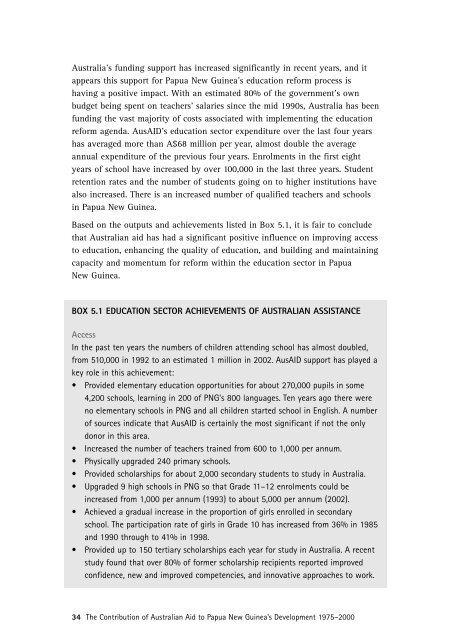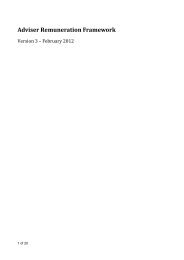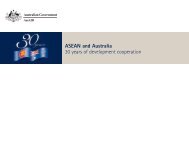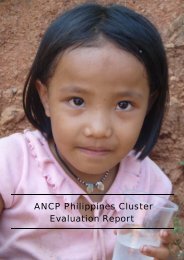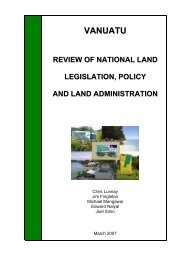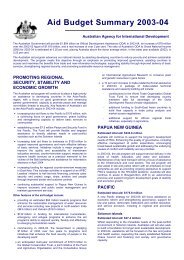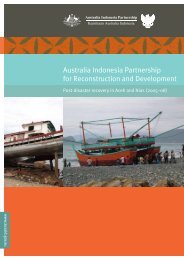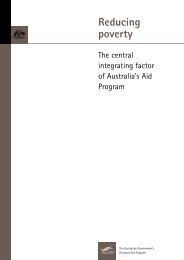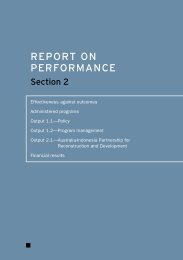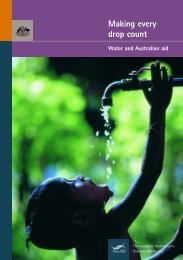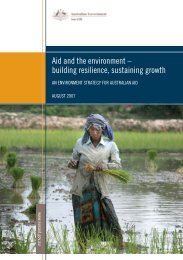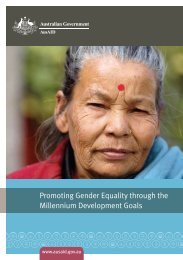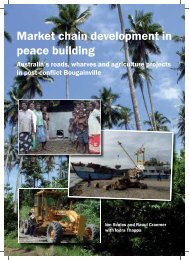Australian Aid to PNG - AusAID
Australian Aid to PNG - AusAID
Australian Aid to PNG - AusAID
Create successful ePaper yourself
Turn your PDF publications into a flip-book with our unique Google optimized e-Paper software.
Australia’s funding support has increased significantly in recent years, and itappears this support for Papua New Guinea's education reform process ishaving a positive impact. With an estimated 80% of the government’s ownbudget being spent on teachers’ salaries since the mid 1990s, Australia has beenfunding the vast majority of costs associated with implementing the educationreform agenda. <strong>AusAID</strong>’s education sec<strong>to</strong>r expenditure over the last four yearshas averaged more than A$68 million per year, almost double the averageannual expenditure of the previous four years. Enrolments in the first eightyears of school have increased by over 100,000 in the last three years. Studentretention rates and the number of students going on <strong>to</strong> higher institutions havealso increased. There is an increased number of qualified teachers and schoolsin Papua New Guinea.Based on the outputs and achievements listed in Box 5.1, it is fair <strong>to</strong> concludethat <strong>Australian</strong> aid has had a significant positive influence on improving access<strong>to</strong> education, enhancing the quality of education, and building and maintainingcapacity and momentum for reform within the education sec<strong>to</strong>r in PapuaNew Guinea.BOX 5.1 EDUCATION SECTOR ACHIEVEMENTS OF AUSTRALIAN ASSISTANCEAccessIn the past ten years the numbers of children attending school has almost doubled,from 510,000 in 1992 <strong>to</strong> an estimated 1 million in 2002. <strong>AusAID</strong> support has played akey role in this achievement:• Provided elementary education opportunities for about 270,000 pupils in some4,200 schools, learning in 200 of <strong>PNG</strong>'s 800 languages. Ten years ago there wereno elementary schools in <strong>PNG</strong> and all children started school in English. A numberof sources indicate that <strong>AusAID</strong> is certainly the most significant if not the onlydonor in this area.• Increased the number of teachers trained from 600 <strong>to</strong> 1,000 per annum.• Physically upgraded 240 primary schools.• Provided scholarships for about 2,000 secondary students <strong>to</strong> study in Australia.• Upgraded 9 high schools in <strong>PNG</strong> so that Grade 11–12 enrolments could beincreased from 1,000 per annum (1993) <strong>to</strong> about 5,000 per annum (2002).• Achieved a gradual increase in the proportion of girls enrolled in secondaryschool. The participation rate of girls in Grade 10 has increased from 36% in 1985and 1990 through <strong>to</strong> 41% in 1998.• Provided up <strong>to</strong> 150 tertiary scholarships each year for study in Australia. A recentstudy found that over 80% of former scholarship recipients reported improvedconfidence, new and improved competencies, and innovative approaches <strong>to</strong> work.34 The Contribution of <strong>Australian</strong> <strong>Aid</strong> <strong>to</strong> Papua New Guinea’s Development 1975–2000


